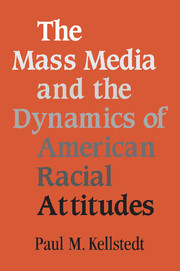Book contents
- Frontmatter
- Contents
- List of Figures
- List of Tables
- Preface
- The Mass Media and the Dynamics of American Racial Attitudes
- 1 Toward a Dynamic Perspective on Racial Attitudes
- 2 Eras of Media Coverage of Race
- 3 Eras of Racial Liberalism and Conservatism
- 4 Media Framing and the Dynamics of Racial Policy Preferences
- 5 The Fusion of Race and the Welfare State in the Public Mind
- 6 A New American Dilemma for a New Millennium?
- Appendix
- References
- Index
4 - Media Framing and the Dynamics of Racial Policy Preferences
Published online by Cambridge University Press: 06 January 2010
- Frontmatter
- Contents
- List of Figures
- List of Tables
- Preface
- The Mass Media and the Dynamics of American Racial Attitudes
- 1 Toward a Dynamic Perspective on Racial Attitudes
- 2 Eras of Media Coverage of Race
- 3 Eras of Racial Liberalism and Conservatism
- 4 Media Framing and the Dynamics of Racial Policy Preferences
- 5 The Fusion of Race and the Welfare State in the Public Mind
- 6 A New American Dilemma for a New Millennium?
- Appendix
- References
- Index
Summary
… the symbols of revolt are not drawn like musty costumes from a cultural closet and arrayed before the public. Nor are meanings unrolled out of whole cloth. The costumes of revolt are woven from a blend of inherited and invented fibers into collective action frames….
– Sidney Tarrow (1998)After at least a decade of leftward drift, racial policy preferences reached a liberal peak in the mid-1960s. But, as we have seen, the era of liberalism was not sustainable in the long run. After a reversal and a long slow but steady march to the right, the public reached a conservative zenith in policy preferences on racial matters around 1980. That conservatism, too, was short-lived, though few observers have noted this fact: opposition to government activism on race eroded steadily throughout the 1980s. And again, in the early 1990s, the public hit a liberal high, but – in what is by now a familiar pattern – support for liberalism has been waning since then. Why?
In search of an explanation, ought we to open the historian's toolkit and point to particular dates, identify “critical moments” in our history where we, like a sailboat, changed tack? Ought we to search through the records of speeches by influential politicians and societal leaders – for surely the eloquence attained in the pursuit of racial equality, with its rich biblical imagery, is among the pinnacles of rhetorical splendor in the history of the republic – to discover how a particular presidential candidate or movement activist stated something with a new and profound kind of power and persuaded plain folk to change their minds?
- Type
- Chapter
- Information
- The Mass Media and the Dynamics of American Racial Attitudes , pp. 83 - 105Publisher: Cambridge University PressPrint publication year: 2003



